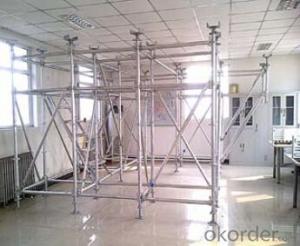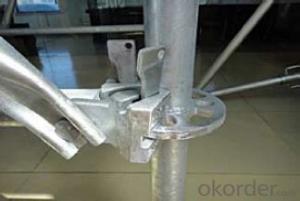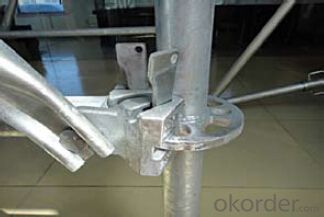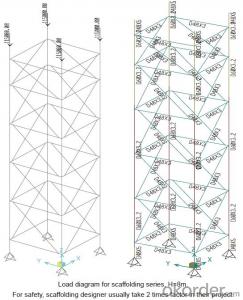Ring-lock scaffolding accessories for Formwork and Scaffolding System
- Loading Port:
- Tianjin
- Payment Terms:
- TT OR LC
- Min Order Qty:
- 50 m²
- Supply Capability:
- 1000 m²/month
OKorder Service Pledge
Quality Product, Order Online Tracking, Timely Delivery
OKorder Financial Service
Credit Rating, Credit Services, Credit Purchasing
You Might Also Like
Ring-lock Scaffolding
A support system for construction, ownsadvantages of both cup-lock scaffolding andshoring tower.
It is in the development direction of new typescaffolding.
It is widely used in buildings, bridges, tunnels etc..
Characteristics:
◆ Easy to storage and transportation
◆ High degree of standardization
◆ Easy and quick erection
◆ Excellent stability and bearing capacity
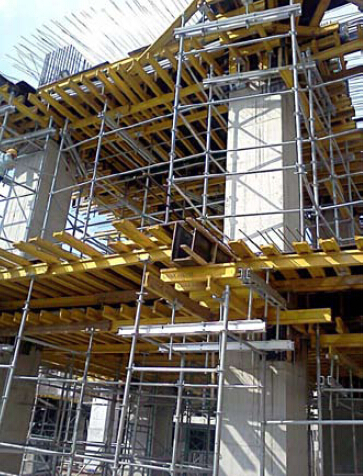
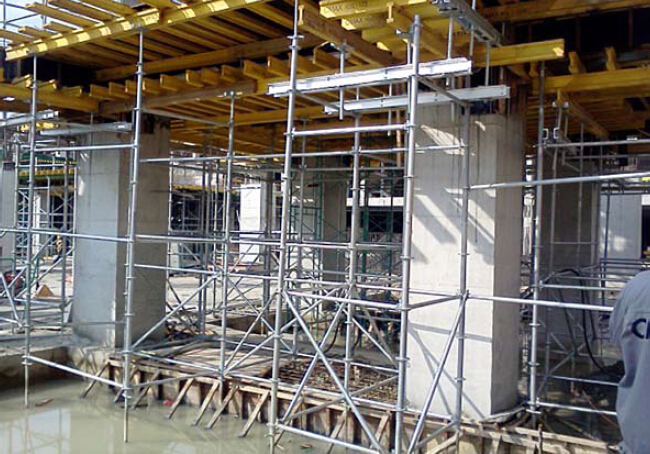
- Q: Can steel formwork be used for curved beams and columns?
- Yes, steel formwork can be used for curved beams and columns. Steel formwork is versatile and can be easily adjusted or shaped to match the desired curvature of the beams and columns. Its strength and rigidity allow it to maintain its shape during the concrete pouring process, ensuring accurate and precise results for curved structures.
- Q: How does steel formwork accommodate for different concrete compaction methods?
- Steel formwork accommodates for different concrete compaction methods by providing a rigid and stable structure that can withstand the pressure and vibrations generated during compaction. The steel panels and frames used in formwork are designed to be strong and durable, ensuring that they can handle the forces exerted by different compaction techniques such as vibration, tamping, or mechanical compaction. Additionally, steel formwork can be easily adjusted or customized to suit specific compaction requirements, allowing for precise shaping and consolidation of the concrete.
- Q: Can steel formwork be easily disassembled and removed after construction?
- Certainly! After construction, it is possible to easily disassemble and remove steel formwork. These formwork systems are specifically designed to be reusable and offer great flexibility when it comes to assembly and disassembly. Typically, the components of steel formwork are lightweight, making them easily manageable and movable by construction workers. Furthermore, steel formwork systems often incorporate adjustable clamps and brackets, enabling swift and efficient dismantling. This not only saves time and labor costs but also permits the reuse of the formwork in future construction endeavors, making it an environmentally-friendly and cost-effective option for construction projects.
- Q: How does steel formwork handle surface imperfections in concrete?
- Construction projects commonly utilize steel formwork to create temporary molds for pouring concrete. One of the benefits of steel formwork is its effective handling of surface imperfections in concrete. The precise and controlled placement of concrete is facilitated by the smooth and rigid nature of steel formwork, which minimizes the occurrence of surface imperfections. Unlike wood or plywood, steel formwork does not flex or warp, ensuring consistent surface finishes. When surface imperfections do arise, steel formwork provides a solid foundation to address these issues. The strength and durability of steel enable it to withstand the pressure exerted by the concrete, preventing bulges or deformations that could result in surface imperfections. Moreover, steel formwork can easily be adjusted or modified to accommodate any irregularities or unevenness in the concrete. This flexibility allows for the correction of minor imperfections during the pouring process, resulting in a smoother and more even surface finish. Furthermore, steel formwork can be treated or coated to prevent sticking or bonding between the concrete and the formwork. This coating reduces the likelihood of surface imperfections caused by the concrete adhering to the formwork. In conclusion, steel formwork is a dependable and efficient solution for dealing with surface imperfections in concrete. Its strength, rigidity, and versatility enable construction professionals to achieve high-quality finishes, even in challenging conditions.
- Q: Can steel formwork be used for tunnel portals?
- Yes, steel formwork can be used for tunnel portals. Steel formwork is known for its durability, strength, and flexibility, making it suitable for constructing tunnel portals. It can withstand the pressures and forces exerted during tunnel construction and provide a stable framework for pouring concrete. Additionally, steel formwork can be easily customized to meet specific design requirements, ensuring the tunnel portals are constructed accurately and efficiently.
- Q: How does steel formwork affect the overall aesthetics of a structure?
- Steel formwork does not have a direct impact on the overall aesthetics of a structure as it is a temporary structure used for shaping and supporting concrete during construction. However, steel formwork can indirectly affect aesthetics by allowing for precise and smooth finishes, resulting in a more visually appealing final product. Additionally, steel formwork's strength and durability ensure structural integrity, which is essential for maintaining the long-term aesthetics of the structure.
- Q: Can steel formwork be used for precast concrete balconies?
- Indeed, precast concrete balconies can make use of steel formwork. Construction frequently employs steel formwork for diverse purposes, encompassing precast concrete components. This approach presents numerous benefits, notably durability, strength, and adaptability. Moreover, steel formwork can effortlessly be tailored to match the precise measurements and configurations required, facilitating the realization of intricate balcony designs. Additionally, it yields a polished surface for the concrete, diminishing the necessity for supplementary finishing tasks. Furthermore, steel formwork can be repeatedly utilized, rendering it an economical choice for precast concrete balconies.
- Q: Can steel formwork be used for both indoor and outdoor construction projects?
- Steel formwork is suitable for both indoor and outdoor construction projects, providing durability and strength. It can withstand different weather conditions, making it an ideal choice for outdoor projects. This material is highly robust and can support the weight of concrete and other construction materials, ensuring stability. Another advantage of steel formwork is its reusability, making it a cost-effective option for both indoor and outdoor projects. Construction professionals widely prefer its versatility and resilience for various applications.
- Q: Can steel formwork be used for swimming pool construction?
- Yes, steel formwork can be used for swimming pool construction. Steel formwork offers durability and strength, making it suitable for creating the required concrete structure of a swimming pool. It is commonly used in the construction industry for various applications, including swimming pool construction.
- Q: Can steel formwork be used for both interior and exterior concrete structures?
- Yes, steel formwork can be used for both interior and exterior concrete structures. Steel is a versatile material that offers exceptional strength and durability, making it suitable for various construction applications. When used as formwork, steel provides a rigid and stable framework that can withstand the pressure exerted by fresh concrete during pouring and curing. This makes it ideal for creating both interior and exterior concrete structures. Steel formwork is commonly used for constructing walls, columns, beams, slabs, and other structural elements in buildings and infrastructure projects. Its robustness allows it to withstand harsh weather conditions and other environmental factors, making it suitable for exterior structures. Additionally, steel formwork can be easily reused multiple times, which makes it a cost-effective choice for both interior and exterior projects. Furthermore, steel formwork offers flexibility in design and can be easily customized to meet specific project requirements. It can be easily assembled and disassembled, allowing for efficient construction processes. The smooth surface of steel formwork also produces high-quality finishes on concrete structures. However, it is important to note that steel formwork requires proper maintenance to ensure its longevity and prevent corrosion. Regular inspections, cleaning, and the application of protective coatings are necessary to maintain the integrity of the formwork. In conclusion, steel formwork is a versatile and reliable choice for both interior and exterior concrete structures. Its strength, durability, and flexibility make it suitable for a wide range of construction projects, providing efficient and high-quality results.
Send your message to us
Ring-lock scaffolding accessories for Formwork and Scaffolding System
- Loading Port:
- Tianjin
- Payment Terms:
- TT OR LC
- Min Order Qty:
- 50 m²
- Supply Capability:
- 1000 m²/month
OKorder Service Pledge
Quality Product, Order Online Tracking, Timely Delivery
OKorder Financial Service
Credit Rating, Credit Services, Credit Purchasing
Similar products
Hot products
Hot Searches
Related keywords
